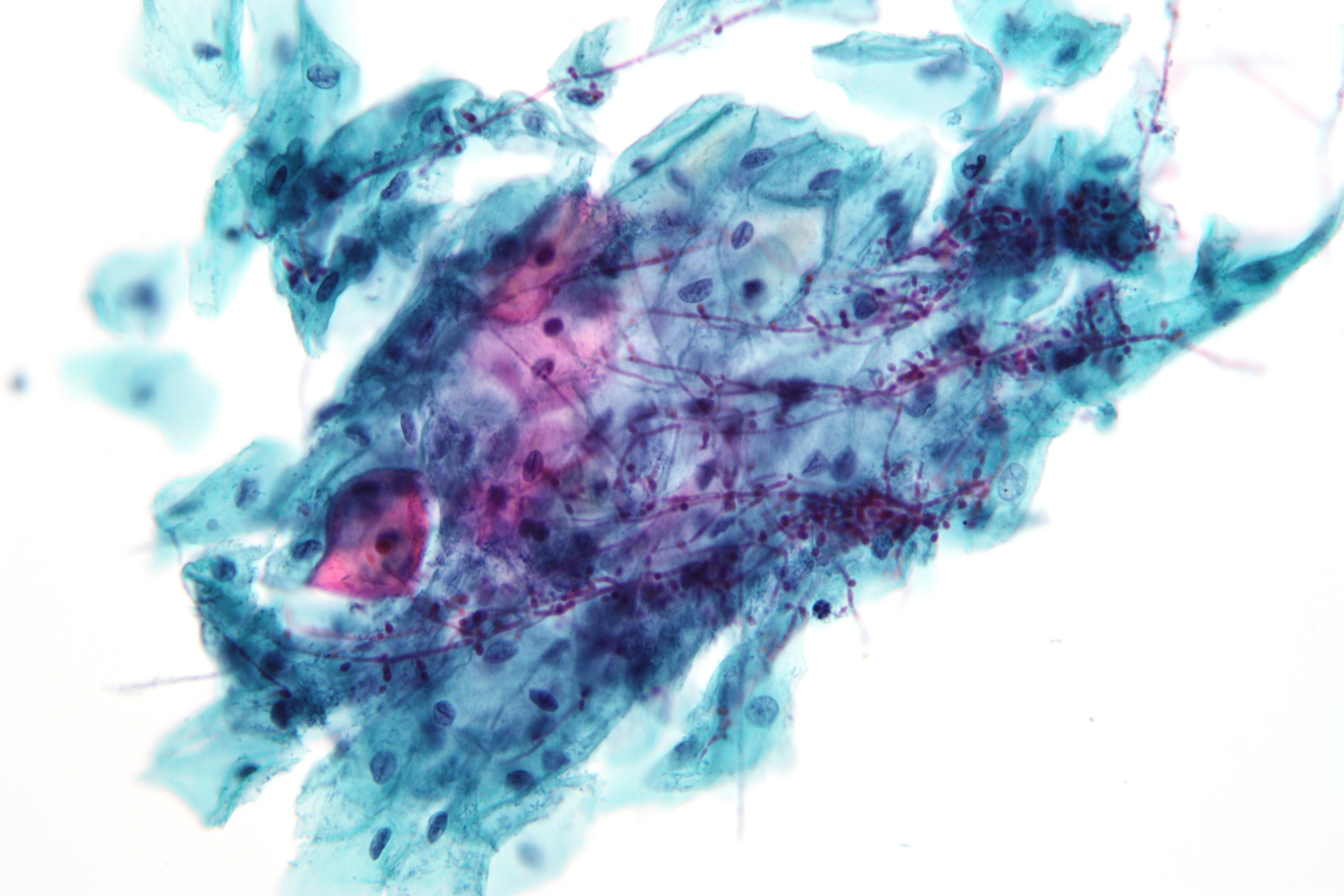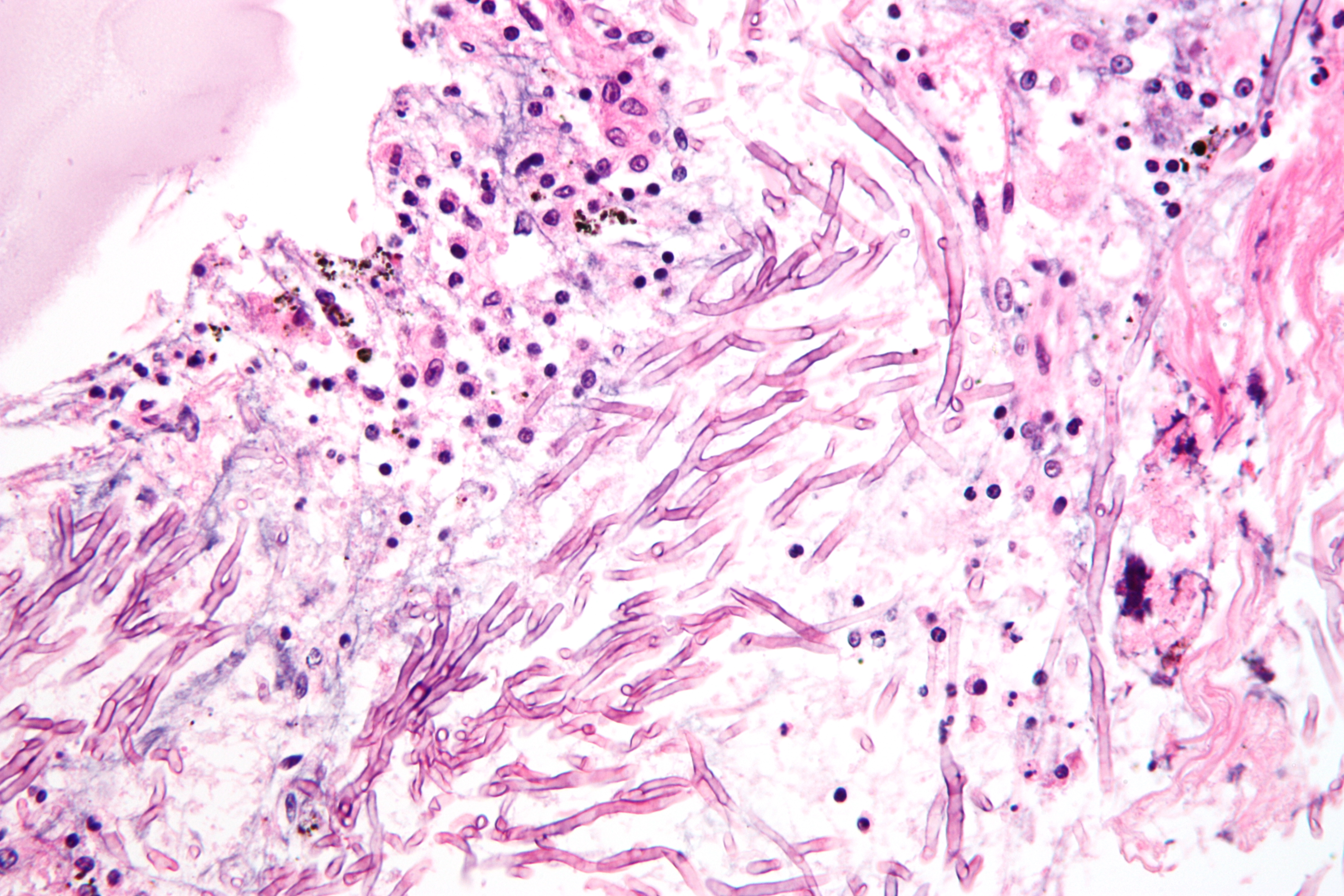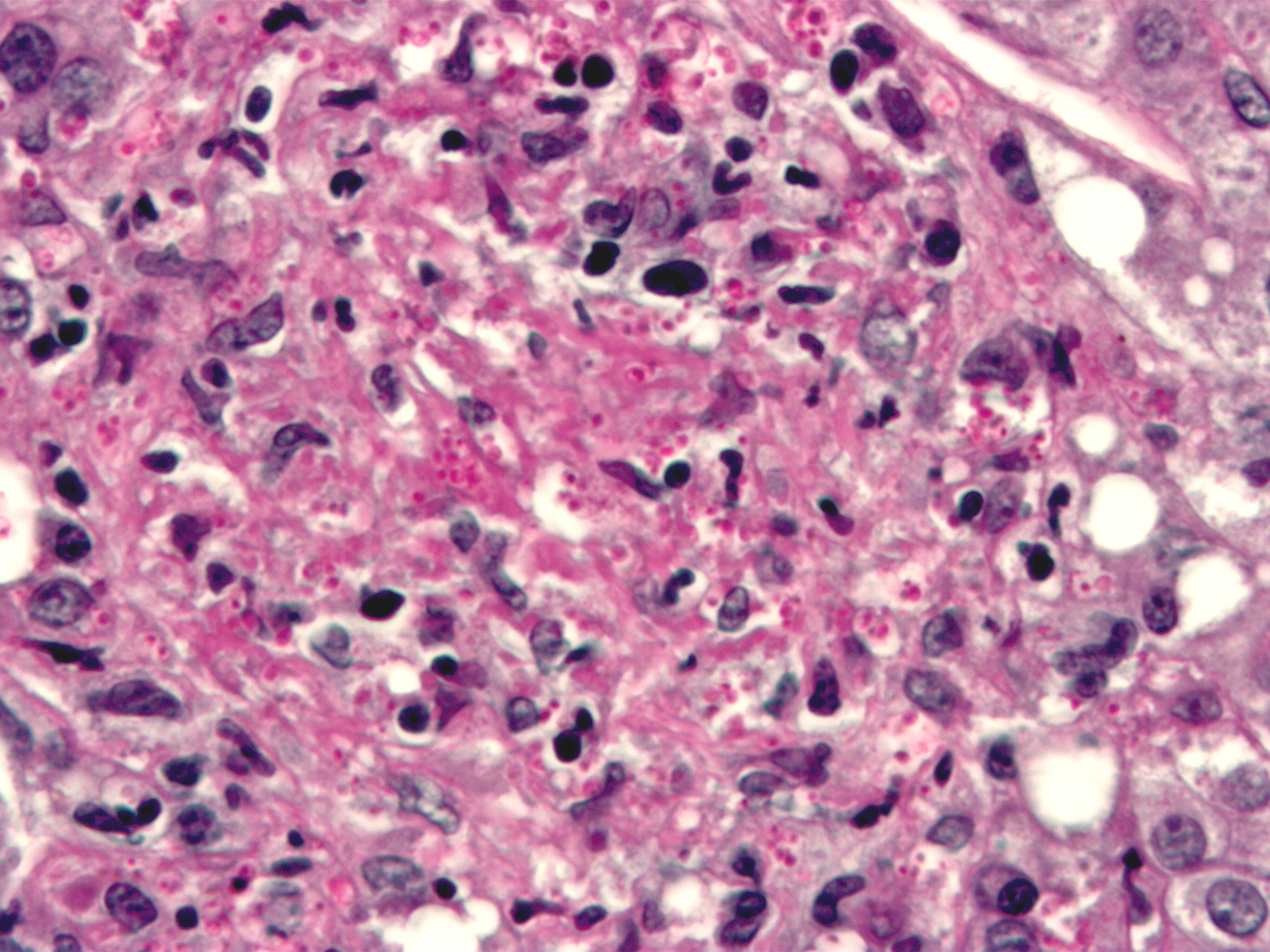Pathogenic fungi on:
[Wikipedia]
[Google]
[Amazon]
Pathogenic fungi are
 ''Candida'' species cause infections in individuals with deficient immune systems. Th1-type
''Candida'' species cause infections in individuals with deficient immune systems. Th1-type
 The most common pathogenic species are '' Aspergillus fumigatus'' and ''
The most common pathogenic species are '' Aspergillus fumigatus'' and ''
 ''
''
 ''
''
Ecmm.eu: Official European Confederation of Medical Mycology website
{{Fungi classification, state=collapsed Fungal diseases, . Fungi and humans Fungus common names Mycology
fungi
A fungus ( : fungi or funguses) is any member of the group of eukaryotic organisms that includes microorganisms such as yeasts and molds, as well as the more familiar mushrooms. These organisms are classified as a kingdom, separately from ...
that cause disease in humans or other organism
In biology, an organism () is any living system that functions as an individual entity. All organisms are composed of cells (cell theory). Organisms are classified by taxonomy into groups such as multicellular animals, plants, and ...
s. Approximately 300 fungi are known to be pathogenic to humans. Markedly more fungi are known to be pathogenic to plant
Plants are predominantly photosynthetic eukaryotes of the kingdom Plantae. Historically, the plant kingdom encompassed all living things that were not animals, and included algae and fungi; however, all current definitions of Plantae exclu ...
life than those of the animal kingdom. The study of fungi pathogenic to humans is called "medical mycology". Although fungi are eukaryotic
Eukaryotes () are organisms whose Cell (biology), cells have a cell nucleus, nucleus. All animals, plants, fungi, and many unicellular organisms, are Eukaryotes. They belong to the group of organisms Eukaryota or Eukarya, which is one of the ...
, many pathogenic fungi are microorganism
A microorganism, or microbe,, ''mikros'', "small") and ''organism'' from the el, ὀργανισμός, ''organismós'', "organism"). It is usually written as a single word but is sometimes hyphenated (''micro-organism''), especially in olde ...
s. The study of fungi and other organisms pathogenic to plants is called plant pathology
Plant pathology (also phytopathology) is the scientific study of diseases in plants caused by pathogens (infectious organisms) and environmental conditions (physiological factors). Organisms that cause infectious disease include fungi, oomy ...
.
''Candida''
 ''Candida'' species cause infections in individuals with deficient immune systems. Th1-type
''Candida'' species cause infections in individuals with deficient immune systems. Th1-type cell-mediated immunity
Cell-mediated immunity or cellular immunity is an immune response that does not involve antibodies. Rather, cell-mediated immunity is the activation of phagocytes, antigen-specific cytotoxic T-lymphocytes, and the release of various cytokines in ...
(CMI) is required for clearance of a fungal infection.
''Candida albicans
''Candida albicans'' is an opportunistic pathogenic yeast that is a common member of the human gut flora. It can also survive outside the human body. It is detected in the gastrointestinal tract and mouth in 40–60% of healthy adults. It is usu ...
'' is a kind of diploid yeast
Yeasts are eukaryotic, single-celled microorganisms classified as members of the fungus kingdom. The first yeast originated hundreds of millions of years ago, and at least 1,500 species are currently recognized. They are estimated to constit ...
that commonly occurs among the human gut microflora
Gut microbiota, gut microbiome, or gut flora, are the microorganisms, including bacteria, archaea, fungi, and viruses that live in the digestive tracts of animals. The gastrointestinal metagenome is the aggregate of all the genomes of the gut mi ...
. ''C. albicans'' is an opportunistic pathogen
An opportunistic infection is an infection caused by pathogens (bacteria, fungi, parasites or viruses) that take advantage of an opportunity not normally available. These opportunities can stem from a variety of sources, such as a weakened immune ...
in humans. Abnormal over-growth of this fungus can occur, particularly in immunocompromised
Immunodeficiency, also known as immunocompromisation, is a state in which the immune system's ability to fight infectious diseases and cancer is compromised or entirely absent. Most cases are acquired ("secondary") due to extrinsic factors that a ...
individuals. ''C. albicans'' has a parasexual cycle
The parasexual cycle, a process restricted to fungi and single-celled organisms, is a nonsexual mechanism of parasexuality for transferring genetic material without meiosis or the development of sexual structures. It was first described by Italian ...
that appears to be stimulated by environmental stress.
Other species of ''Candida'' may be pathogenic as well, including '' Candida stellatoidea, C. tropicalis, C. pseudotropicalis, C. krusei, C. parapsilosis,'' and '' C. guilliermondii.''
''Aspergillus''
 The most common pathogenic species are '' Aspergillus fumigatus'' and ''
The most common pathogenic species are '' Aspergillus fumigatus'' and ''Aspergillus flavus
''Aspergillus flavus'' is a saprotrophic and pathogenic fungus with a cosmopolitan distribution. It is best known for its colonization of cereal grains, legumes, and tree nuts. Postharvest rot typically develops during harvest, storage, and/or ...
''. Aspergillus flavus produces aflatoxin
Aflatoxins are various poisonous carcinogens and mutagens that are produced by certain molds, particularly ''Aspergillus'' species. The fungi grow in soil, decaying vegetation and various staple foodstuffs and commodities such as hay, sweetcorn ...
which is both a toxin and a carcinogen
A carcinogen is any substance, radionuclide, or radiation that promotes carcinogenesis (the formation of cancer). This may be due to the ability to damage the genome or to the disruption of cellular metabolic processes. Several radioactive subs ...
and which can potentially contaminate foods such as nuts. ''Aspergillus fumigatus'' and ''Aspergillus clavatus
''Aspergillus clavatus'' is a species of fungus in the genus ''Aspergillus'' with conidia dimensions 3–4.5 x 2.5–4.5 μm. It is found in soil and animal manure. The fungus was first described scientifically in 1834 by the French mycologist ...
'' can cause allergic
Allergies, also known as allergic diseases, refer a number of conditions caused by the hypersensitivity of the immune system to typically harmless substances in the environment. These diseases include hay fever, food allergies, atopic der ...
disease. Some ''Aspergillus'' species cause disease on grain crops, especially maize
Maize ( ; ''Zea mays'' subsp. ''mays'', from es, maíz after tnq, mahiz), also known as corn (North American and Australian English), is a cereal grain first domesticated by indigenous peoples in southern Mexico about 10,000 years ago. The ...
, and synthesize mycotoxin
A mycotoxin (from the Greek μύκης , "fungus" and τοξίνη , "toxin") is a toxic secondary metabolite produced by organisms of kingdom Fungi and is capable of causing disease and death in both humans and other animals. The term 'mycotoxin' ...
s including aflatoxin
Aflatoxins are various poisonous carcinogens and mutagens that are produced by certain molds, particularly ''Aspergillus'' species. The fungi grow in soil, decaying vegetation and various staple foodstuffs and commodities such as hay, sweetcorn ...
. Aspergillosis
Aspergillosis is a fungal infection of usually the lungs, caused by the genus ''Aspergillus'', a common mould that is breathed in frequently from the air around, but does not usually affect most people. It generally occurs in people with lung di ...
is the group of diseases caused by ''Aspergillus''. The symptoms include fever, cough, chest pain or breathlessness. Usually, only patients with weakened immune system
The immune system is a network of biological processes that protects an organism from diseases. It detects and responds to a wide variety of pathogens, from viruses to parasitic worms, as well as cancer cells and objects such as wood splint ...
s or with other lung conditions are susceptible.
The spores of '' Aspergillus fumigatus'' are ubiquitous in the atmosphere. ''A. fumigatus'' is an opportunistic pathogen. It can cause potentially lethal invasive infection in immunocompromised individuals. ''A. fumigatus'' has a fully functional sexual cycle that produces cleistothecia and ascospores.
''Cryptococcus''
 ''
''Cryptococcus neoformans
''Cryptococcus neoformans'' is an encapsulated yeast belonging to the class Tremellomycetes and an obligate aerobe that can live in both plants and animals. Its teleomorph is a filamentous fungus, formerly referred to ''Filobasidiella neoforman ...
'' can cause a severe form of meningitis and meningo-encephalitis in patients with HIV
The human immunodeficiency viruses (HIV) are two species of ''Lentivirus'' (a subgroup of retrovirus) that infect humans. Over time, they cause acquired immunodeficiency syndrome (AIDS), a condition in which progressive failure of the immune ...
infection and AIDS. The majority of ''Cryptococcus'' species live in the soil and do not cause disease in humans. ''Cryptococcus neoformans
''Cryptococcus neoformans'' is an encapsulated yeast belonging to the class Tremellomycetes and an obligate aerobe that can live in both plants and animals. Its teleomorph is a filamentous fungus, formerly referred to ''Filobasidiella neoforman ...
'' is the major human and animal pathogen. '' Papiliotrema laurentii'' and '' Naganishia albida'', both formerly referred to ''Cryptococcus
''Cryptococcus'' is a genus of fungi in the family Cryptococcaceae that includes both yeasts and filamentous species. The filamentous, sexual forms or teleomorphs were formerly classified in the genus ''Filobasidiella'', while ''Cryptococcus'' ...
'', have been known to occasionally cause moderate-to-severe disease in human patients with compromised immunity. ''Cryptococcus gattii
''Cryptococcus gattii'', formerly known as ''Cryptococcus neoformans'' var. ''gattii'', is an encapsulated yeast found primarily in tropical and subtropical climates. Its teleomorph is ''Filobasidiella bacillispora'', a filamentous fungus belongi ...
'' is endemic to tropical parts of the continent of Africa and Australia and can cause disease in non-immunocompromised people.
Infecting ''C. neoformans'' cells are usually phagocytosed by alveolar macrophage
An alveolar macrophage, pulmonary macrophage, (or dust cell) is a type of macrophage, a professional phagocyte, found in the airways and at the level of the alveoli in the lungs, but separated from their walls.
Activity of the alveolar macropha ...
s in the lung. The invading ''C. neoformans
''Cryptococcus neoformans'' is an encapsulated yeast belonging to the class (biology), class Tremellomycetes and an obligate aerobe that can live in both plants and animals. Its teleomorph is a filamentous fungus, formerly referred to ''Filobasid ...
'' cells may be killed by the release of oxidative and nitrosative molecules by these macrophages. However some ''C. neoformans'' cells may survive within the macrophages. The ability of the pathogen to survive within the macrophages probably determines latency of the disease, dissemination and resistance to antifungal agents. In order to survive in the hostile intracellular environment of the macrophage, one of the responses of ''C. neoformans'' is to upregulate
In the biological context of organisms' production of gene products, downregulation is the process by which a cell decreases the quantity of a cellular component, such as RNA or protein, in response to an external stimulus. The complementary pro ...
gene
In biology, the word gene (from , ; "... Wilhelm Johannsen coined the word gene to describe the Mendelian units of heredity..." meaning ''generation'' or ''birth'' or ''gender'') can have several different meanings. The Mendelian gene is a b ...
s employed in responses to oxidative stress
Oxidative stress reflects an imbalance between the systemic manifestation of reactive oxygen species and a biological system's ability to readily detoxify the reactive intermediates or to repair the resulting damage. Disturbances in the normal ...
.
The haploid nuclei of ''C. neoformans'' can undergo nuclear fusion (karyogamy
Karyogamy is the final step in the process of fusing together two haploid eukaryotic cells, and refers specifically to the fusion of the two nuclei. Before karyogamy, each haploid cell has one complete copy of the organism's genome. In order for ...
) to become diploid. These diploid nuclei may then undergo meiosis
Meiosis (; , since it is a reductional division) is a special type of cell division of germ cells in sexually-reproducing organisms that produces the gametes, such as sperm or egg cells. It involves two rounds of division that ultimately r ...
, including recombination, resulting in the formation of haploid basidiospore
A basidiospore is a reproductive spore produced by Basidiomycete fungi, a grouping that includes mushrooms, shelf fungi, rusts, and smuts. Basidiospores typically each contain one haploid nucleus that is the product of meiosis, and they are ...
s that are able to disperse. Meiosis may facilitate repair
The technical meaning of maintenance involves functional checks, servicing, repairing or replacing of necessary devices, equipment, machinery, building infrastructure, and supporting utilities in industrial, business, and residential installa ...
of ''C. neoformans'' DNA in response to macrophage challenge.
''Histoplasma''
 ''
''Histoplasma capsulatum
''Histoplasma capsulatum'' is a species of dimorphic fungus. Its sexual form is called ''Ajellomyces capsulatus''. It can cause pulmonary and disseminated histoplasmosis.
''H. capsulatum'' is "distributed worldwide, except in Antarctica, but m ...
'' can cause histoplasmosis
Histoplasmosis is a fungal infection caused by '' Histoplasma capsulatum''. Symptoms of this infection vary greatly, but the disease affects primarily the lungs. Occasionally, other organs are affected; called disseminated histoplasmosis, it can ...
in humans, dogs and cats. The fungus is most prevalent in the Americas, India and southeastern Asia. It is endemic in certain areas of the United States
The United States of America (U.S.A. or USA), commonly known as the United States (U.S. or US) or America, is a country primarily located in North America. It consists of 50 states, a federal district, five major unincorporated territori ...
. Infection is usually due to inhaling contaminated air.
''Pneumocystis''
''Pneumocystis jirovecii
''Pneumocystis jirovecii'' (previously ''P. carinii'') is a yeast-like fungus of the genus ''Pneumocystis''. The causative organism of ''Pneumocystis'' pneumonia, it is an important human pathogen, particularly among immunocompromised hosts. Pr ...
'' (or Pneumocystis carinii) can cause a form of pneumonia
Pneumonia is an inflammatory condition of the lung primarily affecting the small air sacs known as alveoli. Symptoms typically include some combination of productive or dry cough, chest pain, fever, and difficulty breathing. The severi ...
in people with weakened immune system
The immune system is a network of biological processes that protects an organism from diseases. It detects and responds to a wide variety of pathogens, from viruses to parasitic worms, as well as cancer cells and objects such as wood splint ...
s, such as premature children, the elderly and AIDS patients.
''Stachybotrys''
'' Stachybotrys chartarum'' or "black mold" can cause respiratory damage and severe headaches. It frequently occurs in houses and in regions that are chronically damp.Host defense mechanisms
Endothermy
Mammalianendotherm
An endotherm (from Greek ἔνδον ''endon'' "within" and θέρμη ''thermē'' "heat") is an organism that maintains its body at a metabolically favorable temperature, largely by the use of heat released by its internal bodily functions inst ...
y and homeothermy are potent nonspecific defenses against most fungi. A comparative genomic study found that in opportunistic fungi there are few if any specialised virulence traits consistently linked to opportunistic pathogenicity of fungi in humans apart from the ability to grow at 37 °C.
Barrier tissues
Theskin
Skin is the layer of usually soft, flexible outer tissue covering the body of a vertebrate animal, with three main functions: protection, regulation, and sensation.
Other animal coverings, such as the arthropod exoskeleton, have different de ...
, respiratory tract, gastrointestinal tract, and the Genitourinary system, genital-urinary tract induced inflammation are common bodily regions of fungal infection.
Immune response
Studies have shown that hosts with higher levels of Cell-mediated immunity, immune response cells such as monocytes/macrophages, dendritic cells, and Natural killer T cell, invariant natural killer (iNK) T-cells exhibited greater control of fungal growth and protection against systemic infection. Pattern recognition receptors (PRRs) play an important role in inducing an immune response by recognizing specific fungal pathogens and initiating an immune response. In the case of mucosal candidiasis, the cells that produce Cytokine, cytokine IL-17 are extremely important in maintaining Innate immune system, innate immunity.Link to extremotolerance
A comprehensive comparison of distribution of Opportunistic Pathogens, opportunistic pathogens and stress-tolerant fungi in the fungal tree of life showed that polyextremotolerance and opportunistic pathogenicity consistently appear in the same fungal orders and that the co-occurrence of opportunism and Extremophile, extremotolerance (e.g. osmotolerance and Psychrotolerant, psychrotolerance) is statistically significant. This suggests that some adaptations to stressful environments may also promote fungal survival during the infection.See also
* List of human diseases associated with infectious pathogens * Microbiology * Microsporidia * Mycology * Plant pathology * Plague Inc.References
Further reading
*External links
Ecmm.eu: Official European Confederation of Medical Mycology website
{{Fungi classification, state=collapsed Fungal diseases, . Fungi and humans Fungus common names Mycology